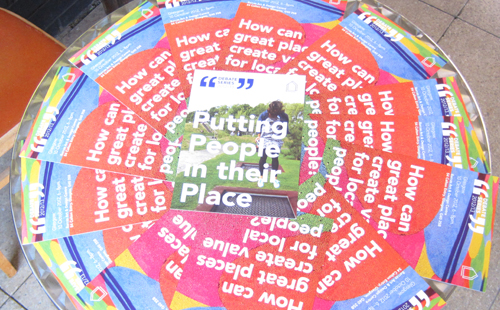Written by:
“Crap places kill people.” Christopher Rowe, a Church of Scotland Minister and resident of one of Glasgow’s most impoverished areas made a searingly honest and powerful statement at the first of our Putting People in their Place debates in Glasgow this week.
We asked our audience and speakers Rowe, Brian Evans and Christopher Breslin, to think about and respond to the question ‘How can great places create value for local people?’. What we got from them was a challenging, engaging and passionate response which unpicked each of the key themes of this year’s series – people, place and value.
Next week we will share the summary of that discussion with you. But on this Friday evening, we would like to share with you Christopher Rowe’s eloquent and considered response to our request.
How can great places create value for local people?
Sometimes it is hard to define what great is, beauty is famously in the eye of the beholder. So perhaps it is worth thinking about the opposite. I am the parish minister for Milton, a 1950’s housing scheme in the north of Glasgow, where I also live. In Milton, as in many of our schemes I reckon there are lots of examples of pretty crap places.
I want to begin with the angle that if crap places diminish value for local people, how can great places create it?
The crap places kill people – built environment is obviously only one factor, but I think it is an important one. According to a Sun article, Milton is Scotland’s Prozac capital, with nearly 20% of the population on prescribed medication for depression or anxiety; suicide is nearly double the national average and male life expectancy is 68 years old, 3 miles away in Bearsden it is 87. Great swathes of Milton have been demolished over the last 15 years, leaving broken landscapes.
So if crap places kill people, what can great places do?
Nothing less than bring life.
One of the ways a great place can bring life is by bringing purpose and meaning to people – not just in the finished product, but in the process. Not just by listening to people’s needs and opinions, the famous community consultations that are touted, but by geting people to build it themselves. Giving them jobs, giving them skills, giving them meaning and creating community. The arduous common task creates community – which is common life.
One of the ways great places can bring life is by bringing beauty and culture, education and peace to unbeautiful places – colour and interest, a positive story. A place of performance and social meeting. A place for quiet reflection – our increasingly unreligious society is not an unspiritual society. Great spaces can act as the window to eternity that draws people upwards. They open people up, widen horizons.
One of the ways great places can bring life is through activity and amenity, jobs and recreation. As well as places of quiet stillness, they are places of noise, socialising, shopping, eating, buying and selling. They counter isolation and enable community.
And great places can create value by not leaving a mess for future generations. They decay beautifully. Like black houses in the Hebrides which return to piles of stone, with nettles growing through them. How much energy goes into creating construction materials which then need huge energy to demolish when redundant? How many leave behind them blighted landscapes? Great places do not require people to live in fuel poverty. Great places do not suck people dry and wreck the world. Financially a great place leaves money in the pocket that a crap place consumes in high energy bills.
Great places bring life – they remind people of nature, its seasons and beauty, its constant change. They are living places.
In every aspect; conception, creation use and disuse they must serve life, they do this by being aware in every step of their journey of their impact and role.
Our sincere thanks to Christopher Rowe of Love Milton for allowing us to share this with you.
